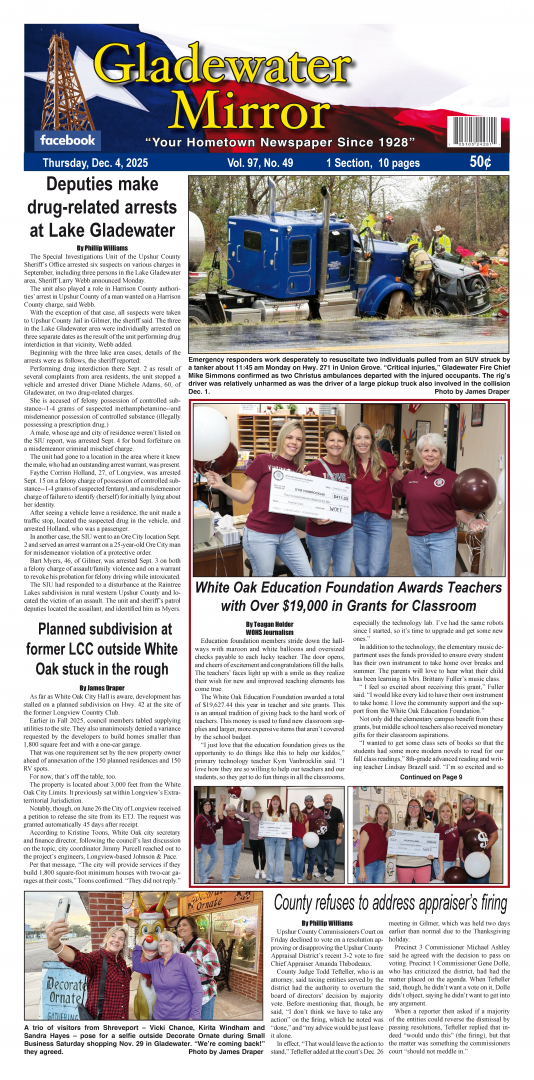There’s an ongoing disparity between White Oak ISD’s local property valuations and the tallies by the state’s appraisers.
Estimates put the gap at more than 10 percent year-to-year, and it’s on the district to square up the two sets of numbers or lose funding for it – as much as $1 million.
The task falls to a law firm of the district’s choosing. That team of experts can bring the school and the state together through various means: by making sure top appraisers are looking at what they ought to, by ensuring the values are accurate, double-checking nothing’s been missed locally and challenging numbers when necessary.
“They want to bring those values together so we stand to lose the least amount of money or none,” according to Dr. William Paul, White Oak Superintendent.
During their July 14 meeting, WOISD trustees heard from Gregg County Chief Appraiser Mark Cormier as well as representatives from three law firms vying to be the district’s advocates on appraisals.
For almost four decades, that’s been McCreary Veselka Bragg & Allen, based in Round Rock. Paul also wanted pitches from Perdue Brandon Fielder Collins & Mott (out of Houston) as well as Linebarger Goggan Blair & Sampson (Austin).
Each firm made their case to carry the torch for White Oak. No decision was made July 14 as the district’s leaders continue to grapple with the situation, looking for the best representative to take up the challenge.
“Local appraisals have to be within a certain range of what Austin’s appraisals are in order to be compliant, for lack of a better word,” Paul explained. “If you are below 95 percent (of the state’s figures) then you get put into what they call a ‘grace period’ where the state does not dock your funding for three years. If after three years your local appraisals have not come into that threshold of what Austin says they have to be then we start losing funding from the state.”
Lately, the state’s values have skyrocketed, he added.
“What’s happened is basically the state’s appraisal district values have escalated a lot faster than what our local property values are. Whatever curve they’re on is much steeper than ours. Ours is still steep, we’ve come up a bunch, but theirs has gone up as much and more.”
Paul doesn’t want to see White Oak go through the same rigors as other districts that reached the end of their three years of grace. If the state won’t go backward for the district to catch up, at least someone could put the brakes on the increases.
“The entity that stands to lose the most is the school district because we’re the one who it’s going to cost funding,” he said. “As a school district, we don’t want to hurt taxpayers any more than they already are. Property values have gone up so much, we know they’re feeling the pain. It’s a pickle.”
With White Oak nearing the end of that grace period, Paul brought in the law firms to get ahead of any problems.
“At the end of the day, I’ve got to do what’s best for White Oak and I want to make sure that whoever’s working for us is going to be in the best interests of White Oak,” Paul said. “If that means getting them all in the same room competing for our business, that’s what we’ll do.”
It’s a statewide issue, Paul said, nothing that the district is facing alone. It’s not simple, however, and he intends to set a public forum in the near future so the district’s taxpayers can better understand the issue.
Unchecked, “It sounds like it could cost us anywhere between $500,000 and $1 million in funding,” Paul said, looking a year down the road. “That’s why it’s important to us that we’re doing everything we can not only to make sure that doesn’t become an issue, but if it does become an issue we’ve got good people behind us to help us fight that battle and do all we can for the students of White Oak.”
In other business during their July 14 meeting, the trustees heard from Paul on handbook updates for the district.
“We are making a couple of adjustments in our business office practices. We have rewritten some of our business policy procedure guideline books,” Paul said later, anticipating board consideration of the finalized changes in August. “It all goes back to making sure we’re efficient here in the business office, and we’re working for the best interests of the taxpayer.”
The trustees heard campus updates from their principals and good news, albeit incomplete, on the school’s STAAR returns.
“We won’t get final results until September,” Paul noted. From initial figures, “The high school really did a great job. Those high school students, teachers and administrators did a great job with that. Scores are still pending for elementary, intermediate and middle school.”
A necessary budget amendment moved money between accounts to cover security improvements at the district.
“We’re doing a lot of installation of cameras and door access and vape sensors in the bathrooms, things like that,” Paul said. All told, the cost will be in excess of $750,000. “Five hundred (thousand) of that is going to be paid through a grant. We’re looking to see if we can get another $250,000 grant-funded as well.
“We’re going to do what we can for the safety and security of our students.”









